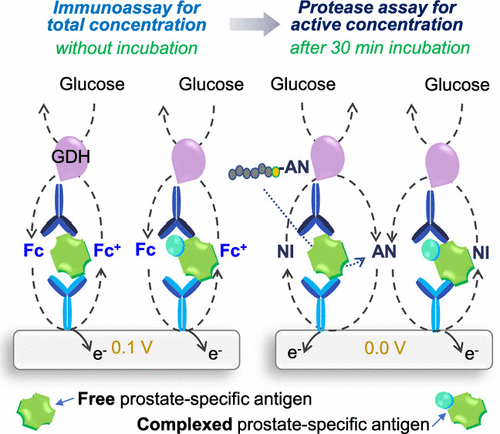Our official English website, www.x-mol.net, welcomes your
feedback! (Note: you will need to create a separate account there.)
Interference-Free Duplex Detection of Total and Active Enzyme Concentrations at a Single Working Electrode
ACS Sensors ( IF 8.2 ) Pub Date : 2021-01-25 , DOI: 10.1021/acssensors.0c02597 Seonhwa Park 1 , Jeonghwa Shin 1 , Jungwook Kwon 1 , Woohyeong Lee 1 , Jihyeon Kim 1 , Gyeongho Kim 1 , Jung Min Joo 1 , Haesik Yang 1
ACS Sensors ( IF 8.2 ) Pub Date : 2021-01-25 , DOI: 10.1021/acssensors.0c02597 Seonhwa Park 1 , Jeonghwa Shin 1 , Jungwook Kwon 1 , Woohyeong Lee 1 , Jihyeon Kim 1 , Gyeongho Kim 1 , Jung Min Joo 1 , Haesik Yang 1
Affiliation

|
The duplex detection of both total and active enzyme concentrations without interferences at a single working electrode is challenging, especially when two different assays are combined. It is also challenging to obtain two different redox-cycling reactions without interference. Here, we present a simple but sensitive combined assay that is based on two redox-cycling reactions using two incubation periods and applied potentials at a single electrode. The assay combines an immunoassay for the determination of the total enzyme (total prostate-specific antigen, tPSA) concentration with a protease assay for the determination of the active enzyme (free PSA, fPSA) concentration. The immunoassay label and fPSA that are affinity-bound to the electrode are used for high sensitivity and specificity in the protease assay as well as the immunoassay. In the immunoassay, electrochemical-enzymatic (EN) redox cycling involving ferrocenemethanol is obtained at 0.1 V versus Ag/AgCl without incubation before the proteolytically released 4-amino-1-naphthol is generated. In the protease assay, EN redox cycling involving 4-amino-1-naphthol is obtained at 0.0 V after 30 min of incubation without ferrocenemethanol electro-oxidation. The detection procedure is almost the same as common electrochemical sandwich-type immunoassays, although the two different assays are combined. The duplex detection in buffer and serum is highly interference-free, specific, and sensitive. The detection limits for tPSA and fPSA are approximately 10 and 1 pg/mL, respectively.
中文翻译:

在单个工作电极上总和活性酶浓度的无干扰双工检测
在单个工作电极上无干扰地同时检测总和活性酶浓度的双重检测具有挑战性,特别是当将两种不同的测定方法结合使用时。在没有干扰的情况下获得两个不同的氧化还原循环反应也是具有挑战性的。在这里,我们提出了一个简单而灵敏的组合测定法,该测定法基于两个氧化还原循环反应,使用两个潜伏期并在单个电极上施加电势。该测定法将用于测定总酶(总前列腺特异性抗原,tPSA)浓度的免疫测定法与用于测定活性酶(游离PSA,fPSA)浓度的蛋白酶测定法结合起来。与电极亲和结合的免疫测定标记和fPSA用于蛋白酶测定和免疫测定中的高灵敏度和特异性。在免疫测定中,在生成蛋白水解释放的4-氨基-1-萘酚之前,无需孵育即可在0.1 V相对于Ag / AgCl的条件下获得涉及二茂铁甲醇的电化学-酶促(EN)氧化还原循环。在蛋白酶分析中,孵育30分钟后,在不对二茂铁甲醇进行电氧化的情况下,于0.0 V下获得了包含4-氨基-1-萘酚的EN氧化还原循环。尽管两种不同的检测方法相结合,但检测程序几乎与普通的电化学夹心型免疫检测法相同。缓冲液和血清中的双重检测高度无干扰,特异且灵敏。tPSA和fPSA的检出限分别约为10 pg / mL和1 pg / mL。1 V相对于Ag / AgCl无需孵育,即可产生蛋白水解释放的4-氨基-1-萘酚。在蛋白酶分析中,孵育30分钟后,在不对二茂铁甲醇进行电氧化的情况下,于0.0 V下获得了包含4-氨基-1-萘酚的EN氧化还原循环。尽管两种不同的检测方法相结合,但检测程序几乎与普通的电化学夹心型免疫检测法相同。缓冲液和血清中的双重检测高度无干扰,特异且灵敏。tPSA和fPSA的检出限分别约为10 pg / mL和1 pg / mL。1 V相对于Ag / AgCl无需孵育,即可产生蛋白水解释放的4-氨基-1-萘酚。在蛋白酶分析中,孵育30分钟后,在不对二茂铁甲醇进行电氧化的情况下,于0.0 V下获得了包含4-氨基-1-萘酚的EN氧化还原循环。尽管两种不同的检测方法相结合,但检测程序几乎与普通的电化学夹心型免疫检测法相同。缓冲液和血清中的双重检测高度无干扰,特异且灵敏。tPSA和fPSA的检出限分别约为10 pg / mL和1 pg / mL。尽管两种不同的检测方法相结合,但检测程序几乎与普通的电化学夹心型免疫检测法相同。缓冲液和血清中的双重检测高度无干扰,特异且灵敏。tPSA和fPSA的检出限分别约为10 pg / mL和1 pg / mL。尽管两种不同的检测方法相结合,但检测程序几乎与普通的电化学夹心型免疫检测法相同。缓冲液和血清中的双重检测高度无干扰,特异且灵敏。tPSA和fPSA的检出限分别约为10 pg / mL和1 pg / mL。
更新日期:2021-03-26
中文翻译:

在单个工作电极上总和活性酶浓度的无干扰双工检测
在单个工作电极上无干扰地同时检测总和活性酶浓度的双重检测具有挑战性,特别是当将两种不同的测定方法结合使用时。在没有干扰的情况下获得两个不同的氧化还原循环反应也是具有挑战性的。在这里,我们提出了一个简单而灵敏的组合测定法,该测定法基于两个氧化还原循环反应,使用两个潜伏期并在单个电极上施加电势。该测定法将用于测定总酶(总前列腺特异性抗原,tPSA)浓度的免疫测定法与用于测定活性酶(游离PSA,fPSA)浓度的蛋白酶测定法结合起来。与电极亲和结合的免疫测定标记和fPSA用于蛋白酶测定和免疫测定中的高灵敏度和特异性。在免疫测定中,在生成蛋白水解释放的4-氨基-1-萘酚之前,无需孵育即可在0.1 V相对于Ag / AgCl的条件下获得涉及二茂铁甲醇的电化学-酶促(EN)氧化还原循环。在蛋白酶分析中,孵育30分钟后,在不对二茂铁甲醇进行电氧化的情况下,于0.0 V下获得了包含4-氨基-1-萘酚的EN氧化还原循环。尽管两种不同的检测方法相结合,但检测程序几乎与普通的电化学夹心型免疫检测法相同。缓冲液和血清中的双重检测高度无干扰,特异且灵敏。tPSA和fPSA的检出限分别约为10 pg / mL和1 pg / mL。1 V相对于Ag / AgCl无需孵育,即可产生蛋白水解释放的4-氨基-1-萘酚。在蛋白酶分析中,孵育30分钟后,在不对二茂铁甲醇进行电氧化的情况下,于0.0 V下获得了包含4-氨基-1-萘酚的EN氧化还原循环。尽管两种不同的检测方法相结合,但检测程序几乎与普通的电化学夹心型免疫检测法相同。缓冲液和血清中的双重检测高度无干扰,特异且灵敏。tPSA和fPSA的检出限分别约为10 pg / mL和1 pg / mL。1 V相对于Ag / AgCl无需孵育,即可产生蛋白水解释放的4-氨基-1-萘酚。在蛋白酶分析中,孵育30分钟后,在不对二茂铁甲醇进行电氧化的情况下,于0.0 V下获得了包含4-氨基-1-萘酚的EN氧化还原循环。尽管两种不同的检测方法相结合,但检测程序几乎与普通的电化学夹心型免疫检测法相同。缓冲液和血清中的双重检测高度无干扰,特异且灵敏。tPSA和fPSA的检出限分别约为10 pg / mL和1 pg / mL。尽管两种不同的检测方法相结合,但检测程序几乎与普通的电化学夹心型免疫检测法相同。缓冲液和血清中的双重检测高度无干扰,特异且灵敏。tPSA和fPSA的检出限分别约为10 pg / mL和1 pg / mL。尽管两种不同的检测方法相结合,但检测程序几乎与普通的电化学夹心型免疫检测法相同。缓冲液和血清中的双重检测高度无干扰,特异且灵敏。tPSA和fPSA的检出限分别约为10 pg / mL和1 pg / mL。











































 京公网安备 11010802027423号
京公网安备 11010802027423号